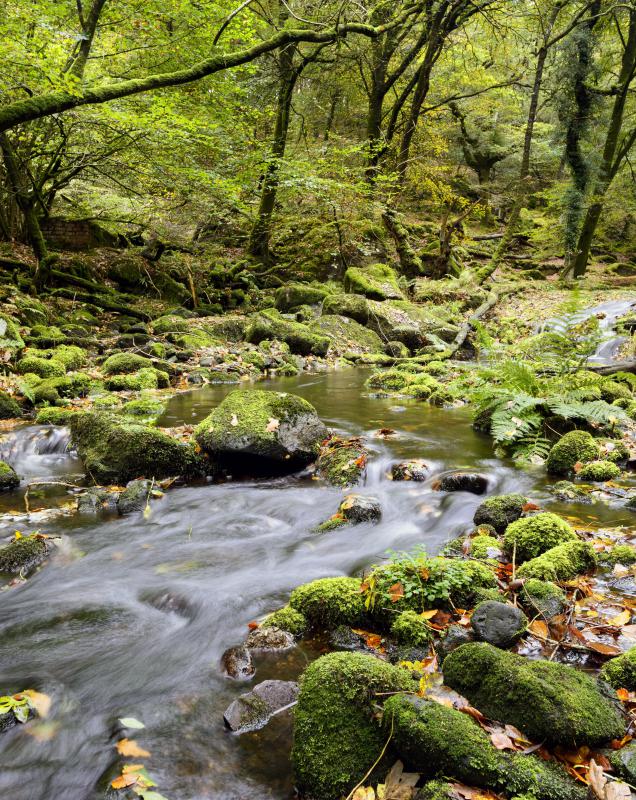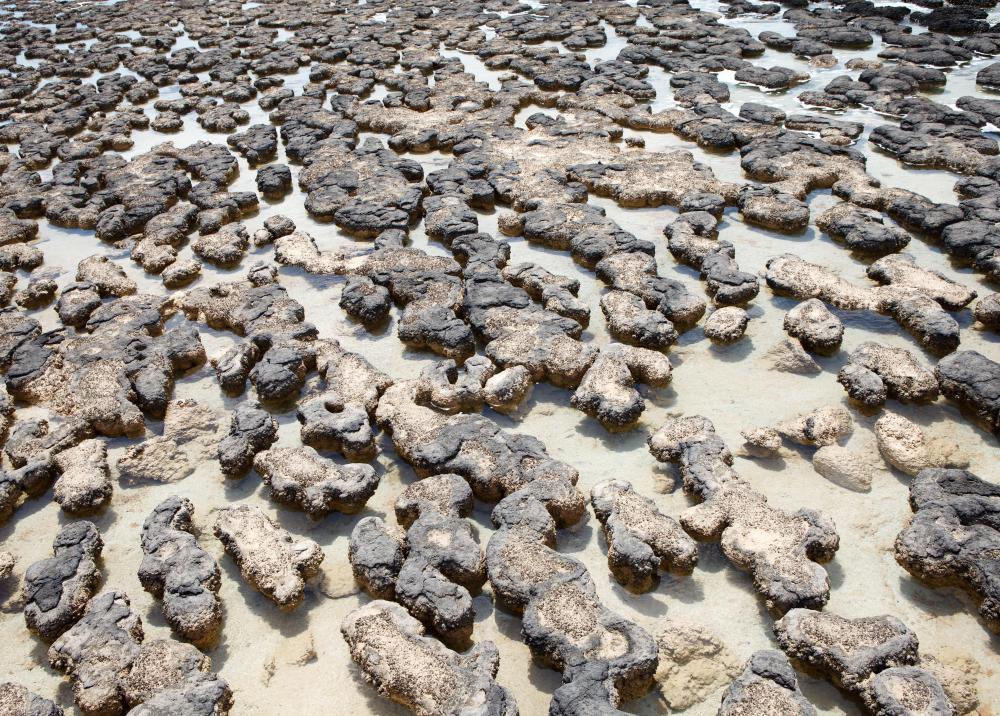At AllThingsNature, we're committed to delivering accurate, trustworthy information. Our expert-authored content is rigorously fact-checked and sourced from credible authorities. Discover how we uphold the highest standards in providing you with reliable knowledge.
What is a Biofilm?
A biofilm is a collection of microscopic organisms which have chosen to attach themselves to each other in the interests of survival. Biofilms can be found all over the world; you are hosting a few yourself, in fact, in the lining of your intestine and on your teeth. Biofilms are also responsible for that weird gunk in your pipes, the slippery rocks in a river, and the streaks of algae you sometimes see on a pond. These aggregations of organisms play a number of unique and interesting roles in many corners of the Earth.
A biofilm is characterized by the sticky adhesive substance which members of the colony secrete. This substance becomes a supportive matrix, pulling the colonists together and protecting them from the outside world. It also works to attract more organisms to the biofilm as it grows, providing numerous appealing anchoring points for these organisms so that they can settle down.

Biofilms tend to thrive in moist environments. They can form either on a hard substrate, like a tooth, or they can form at the boundary between air and water, like the algae which float on ponds and lakes. The formation of a biofilm starts with just a few colonists who attach to the substrate and start to anchor themselves. If these colonists are left undisturbed, others will join them, causing the biofilm to quickly grow. The bacteria in the biofilm can actually communicate with each other using complex molecules, making decisions as a group as they respond to their environment, and at a certain point, the biofilm will break open and disperse, sending colonists to new regions, although a small deposit is usually left behind.

Depending on where a biofilm forms and which organisms are in it, it can be good or bad news. Biofilms are used to clean up oil spills, for example, with scientists releasing colonies of organisms which feed on hydrocarbons. They are also responsible for foodborne illness, as they like to colonize counters and floors. Biofilms can also act as reservoirs for harmful bacteria in hospitals and clinics, which is why these spaces are frequently and rigorously cleaned.

Other biofilms make interesting topics of scientific inquiry. For example, biofilms can be found in the ferociously hot and chemical-saturated waters of hot springs, an environment which scientists previously thought was uninhabitable, and they also lurk in the extremely deep waters near hydrothermal vents. The biofilm is also likely responsible for life on Earth as we know it, as collections of organisms known as stromatolites are probably the source of much of the world's oxygen.
Frequently Asked Questions
What exactly is a biofilm?
A biofilm is a complex aggregation of microorganisms, such as bacteria, algae, fungi, and protozoa, that adhere to each other and to surfaces, often embedded within a self-produced matrix of extracellular polymeric substances (EPS). This EPS provides structural stability and protection to the microbial community, allowing it to thrive in various environments.
How do biofilms form?
Biofilms form through a series of steps starting with the initial attachment of microorganisms to a surface. Following attachment, they begin producing EPS and multiply, leading to the formation of a mature biofilm. Environmental factors such as nutrient availability and flow conditions can influence the development and architecture of a biofilm.
Where can biofilms be found?
Biofilms are ubiquitous in nature and can be found on almost any wet surface. They are commonly observed in aquatic environments, on rocks, in plumbing systems, and on living tissues. Biofilms can also form on medical devices, posing risks for infection, and are a concern in industrial settings where they can affect product purity and process efficiency.
Why are biofilms important in medical and industrial contexts?
In medical settings, biofilms are significant because they can harbor pathogens that are resistant to antibiotics, making infections difficult to treat. According to the National Institutes of Health, biofilms are involved in up to 80% of all microbial infections. In industrial contexts, biofilms can cause biofouling, leading to equipment damage, contamination, and reduced efficiency.
Can biofilms be beneficial?
Yes, biofilms can be beneficial in certain contexts. For example, they play a crucial role in wastewater treatment processes by breaking down organic matter. Additionally, biofilms on plant roots can enhance nutrient uptake and provide protection against pathogens, contributing to sustainable agriculture practices.
How are biofilms removed or controlled?
Removing or controlling biofilms often requires physical or chemical methods. Physical methods include scrubbing or high-pressure washing, while chemical methods involve biocides or disinfectants. In medical settings, strategies like coating surfaces with antimicrobial agents or using targeted enzymes to disrupt the biofilm matrix are being explored to prevent biofilm formation on medical devices.
AS FEATURED ON:
AS FEATURED ON:













Discussion Comments
I think it's so cool how biofilm can be used to clean up oil spills. It's pretty ingenious, actually. However, it doesn't always work, I guess.
I remember seeing a few news stories about it during the BP oil spill in 2010. Remember that one? The oil spill lasted for months and months, and they tried so many different things to stop the spill and get rid of the oil.
Eventually, they used bacteria to try and clean it up. They thought the bacteria were getting rid of the oil from the oil spill, but they later discovered the bacteria were actually eating natural gas.
I'm not sure, but it seems like biofilm might need to be genetically engineered to actually be completely useful during an oil spill.
@Azuza - I agree, biofilm sounds neat, as long as it isn't in my mouth, or my pipes, or giving me food poisoning. I heard about listeria biofilm awhile ago and I was completely horrified!
Basically, as the article said, the film forms on counters, and then the bacteria makes it way into your food. Since you can't see this biofilm, you have no idea you're contaminating your food. Then, once you eat the food you get really sick with food poisoning (and in the case of listeria, you could die).
I guess this is just another argument for keeping your kitchen extra clean!
Biofilms sound gross and interesting at the same time. It's really interesting how members of the biofilm can communicate and make decisions as a group. In fact, the whole process seems ripe for scientific study (although I'm betting someone has already beat me to it!)
However, as interesting as that is, I'm not wild about the idea of having plaque biofilm on my teeth. Plaque is harmful to both your teeth and your overall health. So I would prefer for biofilm to go and be interesting somewhere else besides my mouth!
There may be places where you definitely do *not* want a bacterial biofilm to develop. How about your shower head, for instance? It's warm and moist and bacteria love it. Then... you guessed it, you bathe in it.
Fortunately, it's easy to clean and disinfect your shower head. You just have to soak it overnight in straight white vinegar.
You can do it a few different ways. Some people take a bag of vinegar and attach it to the shower head with a rubber band, but I've never gotten that to work. You can also disconnect the shower head from the shaft that sticks out from the wall. Or if you have a shower massager, it may have a long enough cord that you can just lower the shower head and put it in a bowl or bucket of vinegar. Scrub with a toothbrush after it soaks to get rid of all those yucky pink bits.
Post your comments